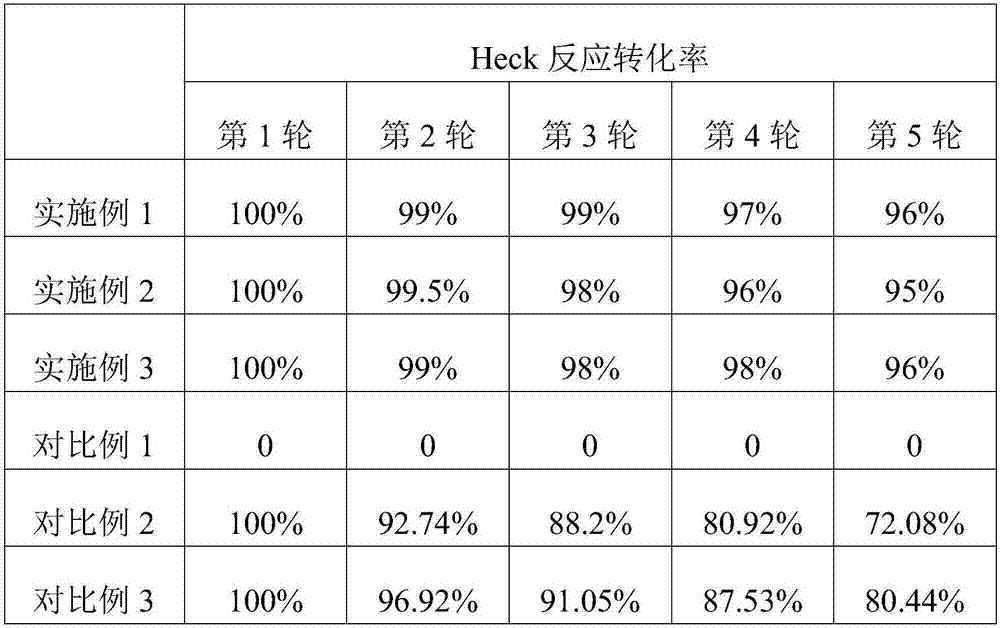Palladium-based dopamine-coated magnetic carbon nano-tube catalyst, and preparation method and application thereof
A technology of magnetic carbon nanotubes and palladium-based dopamine, which is applied in the direction of catalyst activation/preparation, carbon compound catalysts, catalysts, etc., can solve the problems of Pd filtration and loss in the active center, and cannot be applied in the field of pharmaceutical synthesis, so as to suppress the loss, The effect of excellent magnetic separation performance without performance degradation
- Summary
- Abstract
- Description
- Claims
- Application Information
AI Technical Summary
Problems solved by technology
Method used
Image
Examples
preparation example Construction
[0024] A method for preparing a palladium-based dopamine-wrapped magnetic carbon nanotube catalyst proposed in an embodiment of the present invention, comprising:
[0025] 1) Place the carbon nanotubes in a mass fraction of 68% concentrated sulfuric acid, reflux oxidation at 130-150° C. for 10-15 hours, to remove transition metal catalysts and amorphous carbon in the production process of carbon nanotubes, and Carboxyl and other functional groups are grafted on the surface; after the reaction is completed, the mixed solution is cooled, the solid is filtered out, and washed with ethanol and deionized water several times in sequence; the solid mixture is placed in a 60°C water bath and continuously stirred to prevent carbon nanotubes from agglomerating ; After the solid was slowly evaporated to dryness, the black powder sample was placed in a vacuum oven at 60°C for 24 hours to obtain carboxylated carbon nanotubes (CNT);
[0026] 2) Dissolving the nickel salt in a mixed solution...
Embodiment 1
[0037] A method for preparing a palladium-based dopamine-wrapped magnetic carbon nanotube catalyst proposed in an embodiment of the present invention, comprising:
[0038] 1) Place 1g of carbon nanotubes in mass fraction in 68% concentrated sulfuric acid (25mL), reflux oxidation at 140°C for 14h to remove transition metal catalysts and amorphous carbon in the production process of carbon nanotubes, and Carboxyl and other functional groups are grafted on the surface; after the reaction is completed, the mixed solution is cooled, the solid is filtered out, and washed with ethanol and deionized water several times in sequence; the solid mixture is placed in a 60°C water bath and continuously stirred to prevent carbon nanotubes from agglomerating ; After the solid was slowly evaporated to dryness, the black powder sample was placed in a vacuum oven at 60°C for 24 hours to obtain carboxylated carbon nanotubes (CNT);
[0039]2) Dissolving nickel nitrate in a mixed solution of ethano...
Embodiment 2
[0044] A method for preparing a palladium-based dopamine-wrapped magnetic carbon nanotube catalyst proposed in an embodiment of the present invention, comprising:
[0045] 1) Place 1g of carbon nanotubes in mass fraction in 68% concentrated sulfuric acid (25mL), reflux oxidation at 130°C for 15h to remove transition metal catalysts and amorphous carbon in the production process of carbon nanotubes, and Carboxyl and other functional groups are grafted on the surface; after the reaction is completed, the mixed solution is cooled, the solid is filtered out, and washed with ethanol and deionized water several times in sequence; the solid mixture is placed in a 60°C water bath and continuously stirred to prevent carbon nanotubes from agglomerating ; After the solid was slowly evaporated to dryness, the black powder sample was placed in a vacuum oven at 60°C for 24 hours to obtain carboxylated carbon nanotubes (CNT);
[0046] 2) dissolving nickel nitrate in a mixed solution of ethan...
PUM
| Property | Measurement | Unit |
|---|---|---|
| particle size | aaaaa | aaaaa |
| thickness | aaaaa | aaaaa |
| size | aaaaa | aaaaa |
Abstract
Description
Claims
Application Information
 Login to View More
Login to View More - R&D
- Intellectual Property
- Life Sciences
- Materials
- Tech Scout
- Unparalleled Data Quality
- Higher Quality Content
- 60% Fewer Hallucinations
Browse by: Latest US Patents, China's latest patents, Technical Efficacy Thesaurus, Application Domain, Technology Topic, Popular Technical Reports.
© 2025 PatSnap. All rights reserved.Legal|Privacy policy|Modern Slavery Act Transparency Statement|Sitemap|About US| Contact US: help@patsnap.com

